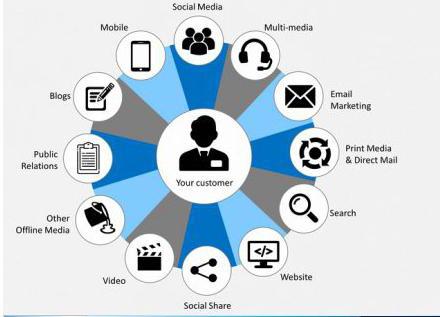Today, the promotion of goods and services is turning into continuous communication with the consumer. In order to win the war against competitors, all companies without exception need marketing communications, which are the main means of attracting customers. The named concept is becoming more and more broad and comprehensive, since the market requires comprehensive promotion.

Marketing concepts
Marketing has traditionally been described as a reach sales market. At the present stage of economic development, it is marketing that becomes a key factor in the success of a company. Since only with his help the product “settles” in the heads of buyers, and only this can lead to a purchase.
Marketing is designed to meet customer needs. Moreover, the concept of "needs" is basic and is subject to constant study, because to know what a potential buyer wants is to be able to make him the right offer.
Need is an awareness of the need for something, a feeling of scarcity, which can be made up in various ways. In marketing, a means of satisfying it is a product, in the broadest sense of the word. The service is also a kind of product, although it has pronounced differences in consumption.
Another basic concept of marketing is the market, which refers to the community of consumers of a product. And marketing is, by and large, a means of communication between consumers and the product, it is with its help that the goods are marketed and reach the buyer.

The essence of the marketing mix
For the first time the existence of the complex marketing (marketing mix) substantiated by Philip Kotler, who wrote that there is a stable set of variables that are used by any company that promotes goods on the market. The purpose of its application is to satisfy the needs of the consumer and increase the effectiveness of the seller.
The traditional marketing mix model is described as 4P: product (product), price (price), place of sale (place), promotion (promotion). This simple model presents the elements and sequence of impact on the market for the purpose of marketing goods. Today, the complex of marketing communications is subjected to constant reform efforts. So, there are 7 and even 11P, and for Internet marketing they offer the 7S model.
Despite numerous discussions about the relevance of the model, the essence and significance of the marketing mix does not decrease. Today, no one doubts that it can be effective only with the competent building of communications, which become an important, and, possibly, the most important element of the marketing mix. 
The concept of marketing communications
Since the promotion of goods on the market is impossible without establishing a connection between the manufacturer and the buyer, there are marketing communications designed to ensure effective satisfaction of consumer needs with the help of goods. They mean informing a potential audience about the benefits and features of the product.
This concept includes the entire process from the development of goods to the design of points of sale and the formulation of an advertising proposal, including the study of the market and the target audience, their needs and needs. Traditional marketing communications tools:
- advertising;
- sales promotion;
- direct sales;
- public relations.
Marketers are carefully planning the use of these funds, based not only on the need for organization, but also on market opportunities and consumer needs. Today, the importance of marketing communications is only growing, since any markets are oversaturated with goods, and purchasing power is growing weakly. And it is the establishment of relationships with the consumer that becomes the key to the success of the company.

Marketing Communication Goals
The concept of promotion can be interpreted very broadly. Moreover, different types of marketing communications help achieve the following global goals:
- communicating information about the product, its features, advantages and innovations to a potential buyer;
- the formation and maintenance of a positive image of the product among consumers;
- creating customer loyalty to the product, maintaining confidence in the product;
- the formation of sustainable demand for goods;
- detuning from competitors in the perception of the consumer;
- creating strong associations of the name and logo with the properties of the product.
These goals, in turn, can be divided into many private tasks, which become the object of communication.

QMS elements: old and new
To solve the numerous challenges facing marketing, various means can. Traditionally, researchers, listing the elements of marketing communications, name four familiar tools:
- advertising
- PR
- personal sales
- sales promotion.
But today, the main marketing communications are complemented by new types, and comes the realization that the roles are changing dramatically. Advertising and PR come out on top, and often they perform the same tasks and cannot exist without each other. The unification of communications is expanding, it now includes:
- branding
- Identity
- sponsorship
- souvenir advertising
- exhibition activities, etc.
Marketing communications are increasingly responsible for the commercial success of companies, and their tools are only expanding and becoming more complex.

Direct Selling Tools
Marketing communications in direct sales this:
- Presentations
- Exhibitions;
- telemarketing;
- direct mail;
- skype consultation;
- personal sales.
They are designed for personal contact between the seller and his client, during which the first can adapt to the characteristics of the buyer and answer his questions and objections. There are two options for building a contact.
- Delivery of a personalized message through various communication channels: by mail, in the form of electronic mailing, distribution of booklets, leaflets, newspapers, magazines.
- Personal contact of the buyer and seller, for which there are many opportunities today: from telephone and video communications to meetings at presentations and various events.
Opinion leaders play a special role in direct sales - they can be experts in various fields, stars or bloggers who will directly talk about the merits of a particular product.

Advertising Tools
The most famous tool of marketing communications is advertising, that is, a message about a product distributed through various mass channels. Its main goal is to inform the buyer about the merits, the formation of the image, a call for action.
The main advertising tools are direct exposure channels:
- outdoor and television advertising;
- Internet advertising;
- messages on the radio and in the press;
- printable advertisement.
In addition, there is an advertisement of indirect impact: at points of sale, on non-traditional media (for example, balloons), in cinemas, airports, etc. Its specificity lies in the mandatory target audience. It is planned so that it is perceived by a potential buyer, only in this case it will be effective.
Advertising is able to convince buyers of the dignity of the product, to form the desired image of the product and the need for it, to create brand recognition when it enters the market. Advertising in the complex of marketing communications performs informative, reminiscent and stimulating functions.
PR Tools
The image function in the marketing mix is performed by public relations. When promoting goods, PR helps to solve problems such as:
- creating a favorable image of the product in the memory of the consumer;
- image correction and positioning;
- the formation of the need for certain goods and interest in them;
- crisis management.
Despite the fact that public relations are mainly used in political and corporate interactions, today more and more often PR tools are used for commercial purposes.
PR tools include: image articles and references in the press, writing and sending out press releases, press conferences, events for journalists, press tours, events for the target audience (for example, holidays, festivals), arranging interviews, sponsorships, exhibitions and trade fairs.
Sales promotion tools
To increase sales, specific tools are used, which are often impossible to use without advertising media. Incentive tools include:
- sales;
- tastings;
- promotions (for example, a gift for a purchase);
- Coupons
- discount and bonus cards;
- Sampling
- lifting;
- contests;
- merchandising and POS materials.
The main function of these funds is an incentive to commit an action, a trial or re-purchase. These tools should have a very quick response, a person should not remember them, so most often they are used in close proximity to points of sale.
Integrated Marketing Communications: All In One
Today, for the qualitative promotion of goods it is impossible to build interaction on only one means. Therefore, integrated marketing communications (IMC) or media mix appear.
Their main advantage is the complexity of the impact. Today, a person is in a large information field, many messages go unnoticed, and only multistage, thoughtful communication can lead to remembering a brand and to buying. Only after hearing about a product from several sources does a person attach value to information, begin to interpret and remember it.
A feature of integrated marketing communications is that their program is not duplication of messages in different media, but the creation of a comprehensive impact program in which messages on different channels deliver different elements of a product message. As a result of this impact, the consumer should have a holistic image of the product. Therefore, IMCs require careful reporting and planning.
Basic principles of integrated marketing communications
The traditional system of marketing communications at the present stage is not able to solve all the tasks assigned to it, so IMC is replacing it. The new approach allows the use of non-traditional and familiar message carriers in order to achieve consumer attention. Integrated marketing communications are based on the following principles:
- synergism - a complex of communications is not a simple sum of messages, but gives a combined effect in which each message carrier plays a role and carries its part of the overall plan;
- openness - IMC is always ready to use the latest ways to disseminate information about the product, open to cooperation and communication;
- personalization - today the consumer is getting used to being approached personally and this trend will only increase due to the growth of Internet communication, therefore, IMCs are being developed for ever smaller segments of consumers.
Benefits of Integrated Marketing Communications
Integrated marketing communications can save budgets for the promotion of goods, as this approach makes it possible to achieve the goal with less effort.
Another advantage of IMC is their ability to reach any consumer who, over time, becomes less and less sensitive to marketing impact.
Traditional advertising channels are steadily losing their effectiveness, so an integrated approach is necessary to achieve communication goals.
Development of marketing communications
Marketing is responsible for the purchase of goods in a highly competitive environment. Marketing communications, in turn, require an integrated approach and phased development, which includes the following steps:
- The study of the target segment, since you need to have a good idea of the needs and interests of the consumer in order to find the right approach to it.
- Market research, in order to take into account all the mistakes and victories of competitors, it is necessary to have a good idea of what they offer to the consumer and at what prices.
- Development of a message in accordance with the characteristics of the product and the target audience.
- Development of a media plan, as it is necessary to select message carriers that correspond to the target group.
- The implementation of the plan.
- Assessment of the effectiveness of communication.








